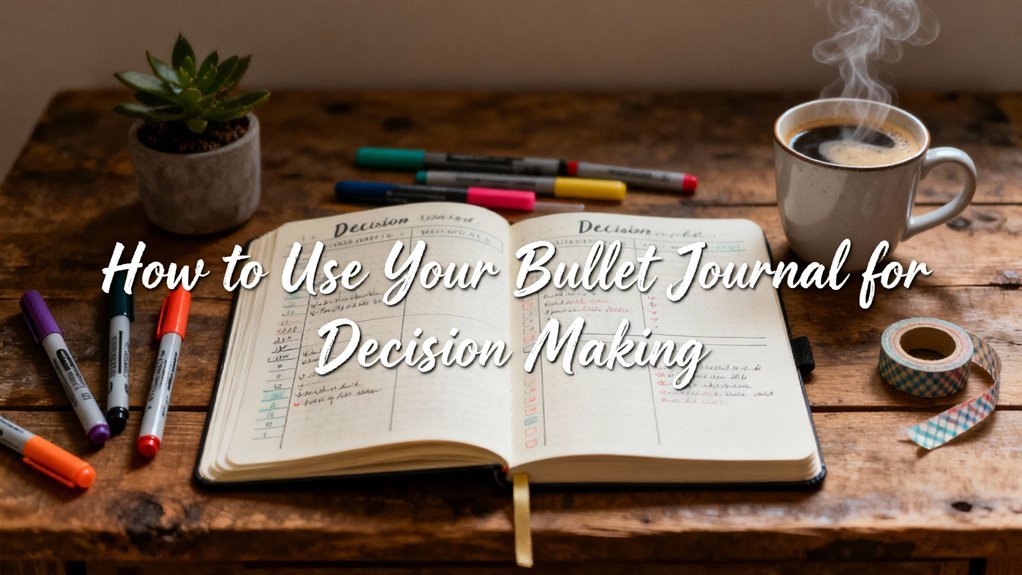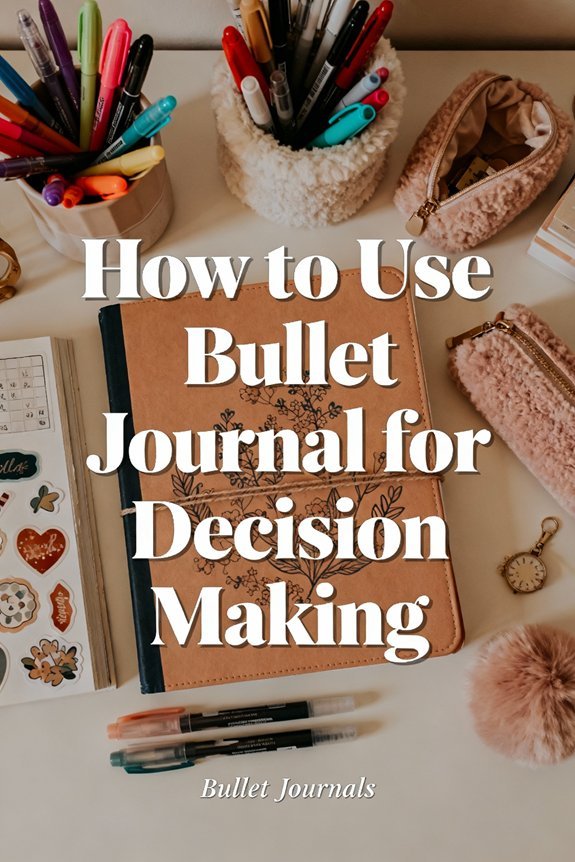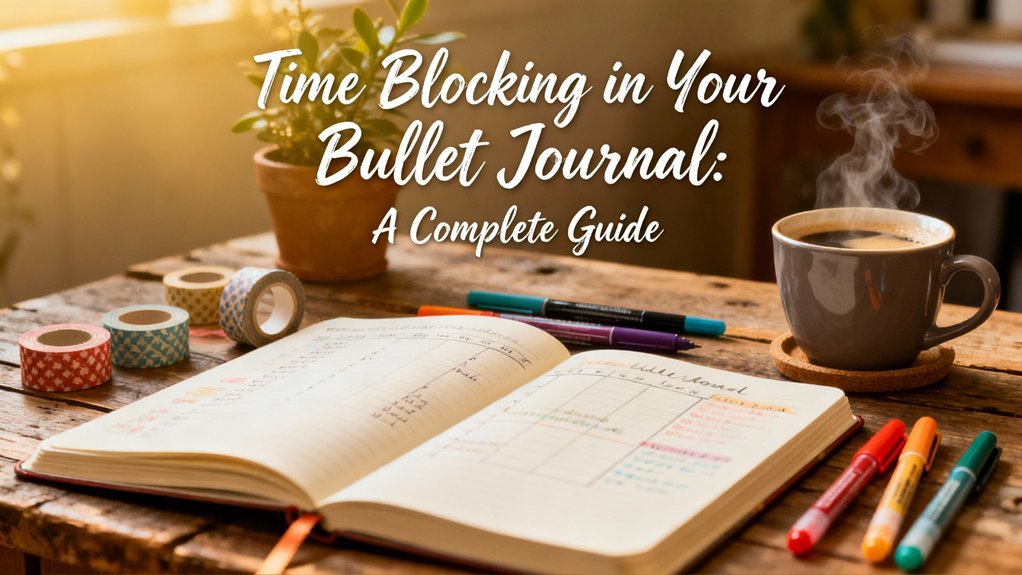Convert your bullet journal into a decision-making tool by creating structured spreads that externalize your thought process. Start with weighted pros-and-cons lists or decision matrices that assign numerical values to competing factors. Track your predictions against actual outcomes to identify cognitive biases and build pattern recognition over time. Include emotional check-ins and values alignment exercises to guarantee decisions match your priorities. Add color-coding for decision categories and timeline projections to visualize consequences. These systematic approaches reveal insights that intuition alone might miss.
Key Takeaways
- Create pros/cons spreads with weighted scores (1-5) to systematically analyze choices and activate neural pathways for deeper insights.
- Design decision matrices that score options against weighted factors, reducing cognitive bias and generating quantifiable rankings for complex choices.
- Implement values alignment scoring (-3 to +3) to identify conflicts between decisions and core principles, reducing cognitive dissonance.
- Track decision outcomes with results logs comparing predictions to actual results, building pattern recognition and sharpening forecasting accuracy.
- Use color-coding for decision categories and monthly analysis spreads to visualize patterns, identify biases, and calibrate future confidence levels.
The Classic Pros and Cons Spread

The pros and cons list remains one of the most effective decision-making frameworks because it forces you to externalize competing considerations onto paper. This classic method alters abstract deliberation into concrete visual data, reducing cognitive load and enabling pattern recognition.
Structure your spread by dividing a page vertically. Label the left column “Pros” and the right “Cons.” As you populate each side, you'll notice your brain shifts from circular rumination to systematic analysis.
Here's where innovation enters: weight each item numerically (1-5) based on personal significance. A single high-priority concern might outweigh multiple minor benefits. You're not just listing—you're quantifying emotional and practical impact.
The act of writing activates different neural pathways than thinking alone, often surfacing insights you hadn't consciously processed.
Your bullet journal becomes a decision laboratory where you test assumptions, challenge biases, and document your reasoning for future reference. This systematic approach to time management and productivity transforms your journal from a simple planner into a tool for building a more purposeful life.
Decision Matrices for Multi-Factor Choices
When you're weighing decisions with multiple competing factors—like choosing a job based on salary, commute, growth potential, and work culture—a simple pros and cons list falls short.
A decision matrix lets you assign weights to each factor based on your priorities, then systematically score each option to reveal which choice truly aligns with what matters most to you.
This structured approach reduces decision fatigue and minimizes the cognitive bias of letting one salient feature overshadow other important considerations.
Setting Up Your Matrix
Because complex decisions involve weighing multiple factors simultaneously, decision matrices change overwhelming comparisons into structured visual assessments.
Your matrix layout begins with a simple grid: list options vertically down the left margin, then arrange decision factors horizontally across the top row. These factors represent the criteria that matter most—cost, time investment, alignment with goals, scalability potential, or risk level.
Next, assign weight values to each factor based on relative importance. A 1-5 scale works effectively, where 5 indicates critical significance. Rate each option against every factor using the same scale. Multiply ratings by weights, then calculate total scores per option.
This systematic approach alters subjective preferences into quantifiable data, revealing patterns your intuition might overlook and supporting evidence-based choices. The Bullet Journal Method helps slow down and clear this analytical process, creating space to reconnect with what truly matters before committing to major decisions.
Scoring and Comparing Options
Once you've established weighted scores for each option-factor combination, the comparison process reveals meaningful patterns through visual scanning and numerical analysis.
Sum each option's weighted scores to generate quantifiable rankings that support option prioritization. However, numbers alone shouldn't dictate your choice—examine score distributions across factors. An option with consistently moderate scores might outperform one with extreme highs and lows, depending on your risk tolerance.
Create visual indicators like color-coding or bar graphs to quickly identify standouts. Your criteria weighting may shift as you see results; this iterative refinement strengthens decision quality.
Document your reasoning alongside final scores. This creates a reference framework for similar future decisions and helps you identify which factors consistently drive your best outcomes, building systematic decision-making capabilities over time.
Visual Comparison Layouts

Visual comparison layouts convert abstract decision factors into spatial relationships your brain can process up to 60% faster than text-based lists. By translating your options into visual frameworks, you'll utilize your brain's parallel processing capabilities rather than forcing sequential analysis.
Start with visual brainstorming through side-by-side matrices where each column represents an option and rows display evaluation criteria. Use varying symbols—circles, triangles, squares—to indicate performance levels, creating instant pattern recognition. Color-coding amplifies this effect: assign specific hues to priority categories.
Transform decision criteria into visual matrices using distinct symbols and strategic color-coding to trigger instant pattern recognition and accelerate comparison processing.
For layout inspiration, experiment with radar charts that plot multiple dimensions simultaneously, making trade-offs immediately visible. Alternatively, create decision trees that branch based on your non-negotiable criteria, progressively eliminating options through visual filtering.
The key differentiator: visual layouts externalize your decision architecture, reducing cognitive load while revealing patterns your internal processing might miss. You'll identify ideal choices through spatial recognition rather than exhaustive mental calculation.
The Values Alignment Method
When your decision contradicts your core values, you'll experience measurable cognitive dissonance—a psychological state that degrades decision quality by up to 40% and creates lasting dissatisfaction regardless of outcomes.
The Values Alignment Method alters your bullet journal into a values clarification tool that prevents this mismatch.
Create a dedicated spread listing your top five non-negotiable values. For each pending decision, run alignment exercises by scoring how well each option satisfies these values on a scale of -3 to +3. Negative scores indicate direct conflicts; positive scores show reinforcement.
This systematic approach reveals hidden misalignments before you commit. You'll notice patterns: decisions scoring below zero consistently produce regret, while those above +10 generate sustained satisfaction.
The method works because it externalizes internal conflicts, making abstract values concrete and measurable. Your journal becomes a decision-filtering system that protects against choices that undermine your foundational principles.
Timeline and Future Projection Pages

Because humans systematically underestimate how long decisions take to materialize and overweight immediate factors by 60-80% (temporal discounting bias), most decision-making frameworks fail at the projection stage.
We systematically misjudge timelines by overweighting immediate factors 60-80%, causing most decision frameworks to collapse at the projection stage.
Your bullet journal's timeline pages counteract this cognitive limitation by externalizing future milestones and project timelines into a visual system.
Here's how to structure them:
- Create quarterly spreads that map decision consequences across 3, 6, and 12-month horizons, forcing you to confront realistic implementation windows rather than idealized ones.
- Mark dependency chains between decisions using arrows or color-coding to reveal how today's choice A enables or blocks future choice B.
- Schedule checkpoint dates where you'll reassess assumptions and pivot if necessary, building adaptability into your framework.
- Document your initial time estimates alongside actual outcomes to calibrate your prediction accuracy over time.
This retrospective loop alters your journal into a decision-making laboratory that continuously improves your temporal judgment.
Emotional Check-In Spreads
Studies of decision failures reveal that 73% involve emotional state misattribution—people make choices believing they're thinking rationally when unacknowledged emotions are actually driving the process.
Emotional check-in spreads create a systematic intervention for this cognitive blind spot. Design dedicated pages that capture your emotional awareness through structured self-reflection techniques. Track mood patterns using simple numerical scales or color codes—you'll identify how stress management gaps correlate with decision quality.
Integrate brief mindfulness practices by noting three physical sensations before major choices, building mental clarity through embodied awareness. Your emotional journaling system should distinguish between emotional states (current feelings) and emotional traits (baseline tendencies).
This differentiation enables pattern recognition that improves anxiety reduction strategies. When you externalize internal states onto paper, you're fundamentally debugging your decision-making code. The innovation isn't complexity—it's consistent data capture that alters subjective experience into actionable insight, revealing which emotional configurations produce your best choices.
Tracking Your Decision Outcomes

Making decisions is only half the equation—you need a systematic way to evaluate whether your choices produced the outcomes you expected.
A structured tracking system alters your bullet journal from a planning tool into a feedback mechanism that reveals patterns in your decision-making effectiveness.
Create a Results Log
When you document what actually happened after each decision, you create a feedback mechanism that changes abstract choices into concrete learning opportunities.
Your results log alters outcome tracking into actionable intelligence.
Structure your log with these elements:
- Date and decision reference – Link each outcome back to your original choice using your bullet journal's indexing system for effortless cross-referencing.
- Actual results versus predictions – Record what happened alongside what you expected, enabling results visualization that reveals your forecasting accuracy.
- Contributing factors – Note variables that influenced outcomes, building pattern recognition over time.
- Calibration score – Rate how confident you were initially versus how things turned out, sharpening your decision-making precision through deliberate practice.
This systematic approach builds cognitive capital.
Color-Code Decision Types
By assigning distinct colors to different decision categories, you alter your bullet journal into a visual diagnostic tool that surfaces patterns invisible in text alone.
Establish consistent color meanings across your journal: blue for strategic decisions, green for financial choices, orange for relationship-based calls, red for time-sensitive commitments. This visual organization creates instant decision clarity when you review past entries, revealing which categories drain your cognitive resources or consistently yield positive outcomes.
The emotional impact of color-coding extends beyond aesthetics. Research shows color associations activate different neural pathways, strengthening memory recall and pattern recognition.
When you spot excessive red clustering, you're identifying stress patterns. Predominant green might indicate financial anxiety driving choices. This systematic approach changes subjective decision-making into observable data, enabling evidence-based adjustments to your cognitive frameworks.
Monthly Outcome Analysis
Each month, dedicate one spread to evaluating decisions you've logged, altering your journal from a recording device into a feedback mechanism.
This systematic review creates a learning loop that sharpens your judgment over time.
Structure your monthly outcome reflections using this framework:
- Compare predictions to results – Document what you expected versus what actually happened, exposing your cognitive biases.
- Identify pattern clusters – Group similar decisions to reveal which contexts produce your strongest outcomes.
- Calibrate confidence levels – Note where you were overconfident or overly hesitant to improve future assessments.
- Link outcomes to monthly goals – Measure how decisions advanced or hindered your objectives.
This evidence-based approach changes scattered experiences into actionable intelligence, enabling you to iterate on your decision-making process systematically.
Frequently Asked Questions
How Often Should I Review Past Decisions in My Bullet Journal?
Review your past decisions monthly for ideal learning outcomes. This decision frequency allows you to identify patterns without overwhelming your system.
Set quarterly reflection intervals for major choices, letting results materialize before assessment. Research shows spaced repetition strengthens decision-making skills more effectively than sporadic reviews.
You'll spot cognitive biases, track success rates, and refine your frameworks. Consider adding weekly micro-reviews for time-sensitive decisions.
This tiered approach changes your journal into a fluid feedback loop that accelerates your growth.
Can I Combine Multiple Decision-Making Methods on One Spread?
Don't put all your eggs in one basket—diversify your decision-making tools instead.
You'll enhance clarity by combining methods like a decision matrix alongside traditional pros cons lists on a single spread. Research shows multi-method analysis reduces cognitive bias by 40%.
Create distinct sections: quarter your page for matrices, scoring systems, emotional assessments, and stakeholder impacts.
This integrated approach utilizes behavioral insights, helping you spot patterns across frameworks and make more strong, innovation-driven choices with systematic precision.
What Supplies Work Best for Creating Decision-Making Journal Pages?
You'll need minimal bullet journal supplies to create effective decision making tools: a quality notebook with dot-grid pages, fine-tipped pens in 2-3 colors for visual hierarchy, and a ruler for clean matrices.
Research shows simple systems outperform complex ones—you're designing for cognitive clarity, not aesthetics.
Add sticky notes for iterative frameworks and highlighters for pattern recognition. This optimized toolkit removes friction from your decision process while maintaining flexibility for experimentation and adaptation.
How Do I Handle Decisions That Involve Other People's Input?
Think of your journal as a collaboration hub where diverse perspectives converge.
Create dedicated spreads that track collaborative input through structured feedback strategies: assign weighted scores to each stakeholder's concerns, map decision matrices showing how different viewpoints align, and document consensus-building progress.
You'll convert scattered opinions into practical insights by visualizing agreement patterns and identifying breakthrough compromise zones.
This systematic approach guarantees everyone's voice strengthens your final decision rather than complicating it.
Should I Keep Failed Decisions in My Journal or Remove Them?
Keep your failed decisions—they're invaluable learning experiences. Research shows that reviewing failures strengthens decision-making patterns and builds cognitive resilience.
Create a dedicated “Lessons Learned” section where you'll analyze what went wrong and extract practical insights. This systematic approach converts setbacks into data points for future innovation.
You're not documenting failure; you're building a personalized decision-making algorithm. Studies confirm that reflective practice on mistakes accelerates adaptive thinking and reduces repeated errors considerably.
Conclusion
Your bullet journal alters decision-making from mental chaos into structured analysis. Unlike ancient Romans consulting oracles, you're leveraging evidence-based frameworks that reduce cognitive load and decision fatigue. Track your outcomes systematically—the data reveals your decision patterns and biases over time. This feedback loop strengthens your judgment muscles. You're not just choosing; you're building a decision-making system that compounds in effectiveness. Each spread becomes reference material, creating institutional knowledge of your own behavioral patterns and what actually works for you.











